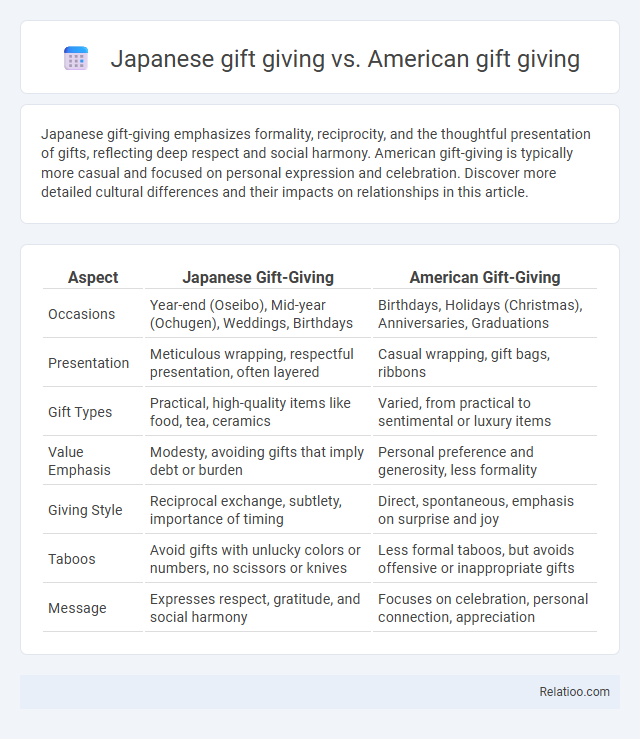Japanese gift-giving emphasizes formality, reciprocity, and the thoughtful presentation of gifts, reflecting deep respect and social harmony. American gift-giving is typically more casual and focused on personal expression and celebration. Discover more detailed cultural differences and their impacts on relationships in this article.
Table of Comparison
| Aspect | Japanese Gift-Giving | American Gift-Giving |
|---|---|---|
| Occasions | Year-end (Oseibo), Mid-year (Ochugen), Weddings, Birthdays | Birthdays, Holidays (Christmas), Anniversaries, Graduations |
| Presentation | Meticulous wrapping, respectful presentation, often layered | Casual wrapping, gift bags, ribbons |
| Gift Types | Practical, high-quality items like food, tea, ceramics | Varied, from practical to sentimental or luxury items |
| Value Emphasis | Modesty, avoiding gifts that imply debt or burden | Personal preference and generosity, less formality |
| Giving Style | Reciprocal exchange, subtlety, importance of timing | Direct, spontaneous, emphasis on surprise and joy |
| Taboos | Avoid gifts with unlucky colors or numbers, no scissors or knives | Less formal taboos, but avoids offensive or inappropriate gifts |
| Message | Expresses respect, gratitude, and social harmony | Focuses on celebration, personal connection, appreciation |
Introduction to Japanese and American Gift-Giving Cultures
Japanese gift-giving culture emphasizes respect, thoughtfulness, and the importance of presentation, often involving elaborate wrapping and symbolic items to convey appreciation and social harmony. In contrast, American gift-giving tends to focus on practicality and personalization, reflecting individual preferences and occasions such as birthdays, holidays, or milestones. Understanding these cultural nuances reveals how gift-giving functions as a social language that strengthens relationships and expresses values in Japan and the United States.
Historical Roots of Gift-Giving Traditions
Japanese gift-giving traditions are deeply rooted in concepts of honor, respect, and reciprocity, influenced by centuries-old customs like the practice of "ochugen" and "oseibo" gifts exchanged during mid-year and year-end. American gift-giving, shaped by cultural melting pots and commercialism, emphasizes personalization and celebration of individual milestones, reflecting a more casual and consumer-driven approach. Understanding your role within these historical contexts reveals the cultural significance and social expectations tied to gift exchanges worldwide.
Social Etiquette: When and Why Gifts Are Given
Japanese gift-giving emphasizes formal occasions like seasonal events, business meetings, and expressions of gratitude, reflecting deep respect and social harmony. In American culture, gifts are often given during birthdays, holidays, and personal milestones, highlighting individual relationships and celebration. Understanding these social etiquettes helps you navigate cultural expectations and express appreciation appropriately in both contexts.
Gift Selection: Meaning and Symbolism
Gift selection in Japanese culture emphasizes deep meaning and symbolism, where presents such as seasonal fruits or tea sets convey respect and gratitude. In American gift-giving, choices often reflect personal preferences and celebrate individuality, highlighting what will delight or surprise the recipient. Understanding these cultural nuances helps you select gifts that honor traditions and express sincere sentiments effectively.
Presentation and Wrapping Customs
Japanese gift-giving places tremendous emphasis on exquisite presentation and meticulous wrapping, often using traditional materials like furoshiki cloth and precise folding techniques to convey respect and thoughtfulness. In contrast, American gift-giving typically features bright, colorful wrapping paper and bows, emphasizing festive occasions and personal expression. Your choice in gift presentation plays a crucial role in reflecting cultural values, where Japanese customs prioritize subtle elegance while American styles focus on celebration and individuality.
The Role of Reciprocity and Obligations
Gift-giving in Japan deeply emphasizes reciprocity and social obligations, where gifts are often exchanged to maintain harmony and show respect within relationships. In contrast, American gift-giving tends to focus more on personal expression and celebration, with less expectation of immediate reciprocal exchange. Understanding these cultural differences can help you navigate the expectations tied to gift-giving, ensuring your gestures are appropriately received in diverse social contexts.
Expressions of Gratitude and Acceptance
In Japanese gift-giving culture, expressions of gratitude are often formal and accompanied by respectful gestures like bowing, emphasizing humility and appreciation. American gift-giving tends to feature more spontaneous verbal thanks and reciprocal gift exchanges, reflecting individualism and personal connection. Both cultures value sincere acceptance of gifts, but Japanese etiquette prioritizes modesty and indirect communication, while American customs encourage open acknowledgment and enthusiastic appreciation.
Gift-Giving in Business and Professional Contexts
Gift-giving in business and professional contexts varies significantly between Japan and the United States, reflecting cultural values and relationship-building strategies. In Japan, gift-giving is a highly formalized practice emphasizing respect, reciprocity, and long-term partnership, often involving meticulously chosen, high-quality items presented with both hands and accompanied by proper etiquette. Your awareness of these cultural nuances can enhance professional relationships and avoid misunderstandings, while American business gift-giving tends to be more casual, pragmatic, and focused on celebrating milestones or expressing appreciation without the same ritualistic formalities.
Common Faux Pas and Cultural Sensitivities
In Japanese gift-giving, it is crucial to avoid gifts with numbers like four, which is associated with death, and to present gifts with both hands as a sign of respect, while American gift-giving typically permits casual exchanges but frowns upon overly expensive or impractical gifts. Common faux pas in Japan include unwrapping gifts immediately in front of the giver, which may be seen as impolite, whereas in American culture, not acknowledging a gift promptly can be perceived as rude. Understanding cultural sensitivities such as the emphasis on humility and reciprocity in Japan versus the focus on personal expression and surprise in the United States can prevent misunderstandings and enhance the gift-giving experience.
Evolving Trends in Contemporary Gift-Giving
Japanese gift-giving emphasizes formality, meticulous presentation, and symbolic meanings rooted in cultural traditions, while American gift-giving tends to prioritize personal expression, convenience, and varied occasions. Contemporary gift-giving trends show a shift towards sustainable, experience-based, and personalized gifts across both cultures, reflecting global consumer awareness and technological advancements. The evolving landscape also highlights the impact of digital platforms and e-commerce, making gifting more accessible, diverse, and tailored to individual preferences worldwide.

Infographic: Japanese gift-giving vs American gift-giving
 relatioo.com
relatioo.com